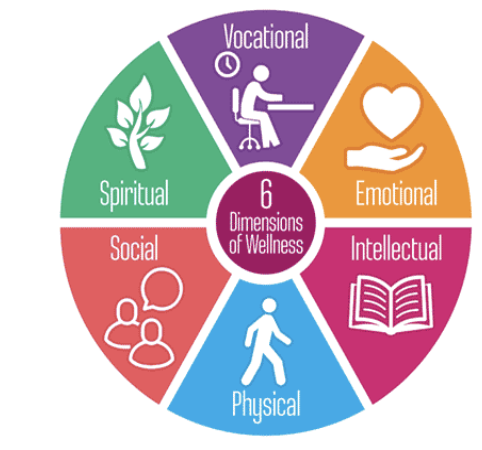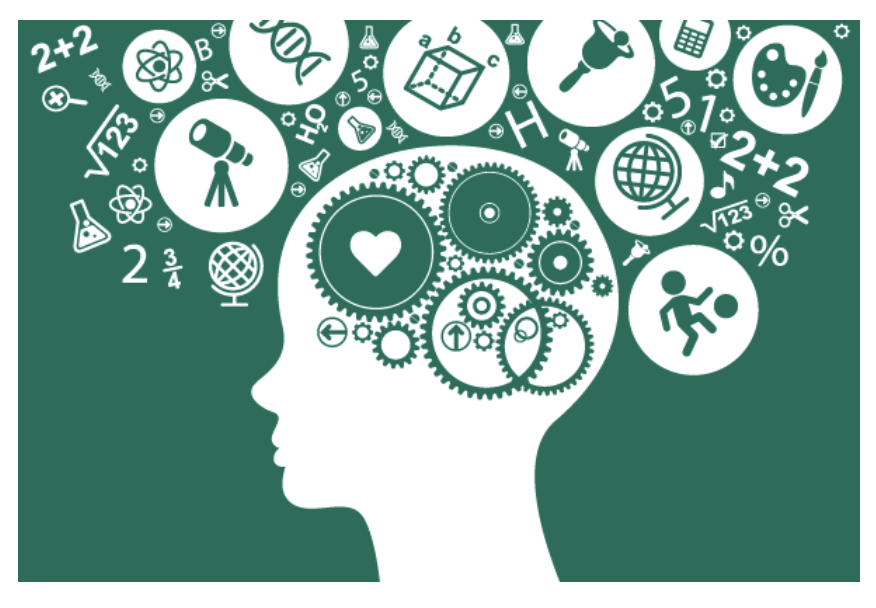By: Sarai Ordonez
The World Health Organization defines health as “a state of complete physical, mental, and social well-being, and not merely the absence of disease or infirmary.” This definition basically states that health is more than just being sick or healthy. Health is a wide spectrum that fluctuates daily and has multiple parts and key factors that can affect it. Health effects everyone and we all have the ability to improve our health through conscious efforts!
So we will be focusing on the dimensions of wellness.
The Dimensions of Wellness model was originally developed by Dr. Bill Hettler at the National Wellness Institute and included only six dimensions. However some models now include 8 dimensions and add financial and environmental to the wheel.
The dimensions of wellness model is a holistic and interdependent model, meaning that every dimension affects the other and together, all of the dimensions contribute to a healthy life.
Health is a central part of human happiness and wellbeing.
Wellness is very important because every behavior we engage in and every emotion we feel affects our wellbeing. Wellbeing also affects our actions and emotions as well, demonstrating the interdependence of this model. For example, When you feel physically sick, like the flu or a stomach virus, you are more likely to be short with others and get angry or be frustrated.
So let's get into the different dimensions of wellness.
First dimension we’re going to talk about is the physical dimension. The physical dimension is the dimension everyone thinks of when they think of health. It’s essentially caring for your body. It encompasses everything dealing with your physical body such as nutrition, exercise, biological illness and sleep. It also includes getting help when you need it, like going to the doctor when you feel sick. and paying attention to the signs of illness given by your body.
So how can we ensure we are physically fit? The Center for Disease Control and Prevention recommends 150 minutes of physical activity every week for adults. This might sound like a lot but when split up, it’s only 30 minutes per day for 5 days a week. Setting a reminder on your phone M-F to complete 30 minutes of physical activity can increase the chances of you actually engaging in it. It’s all about the priority you place on it. And trust me, your health is worth prioritizing!
Next we’re going to talk about the social dimension of wellness. The social dimension encourages engagement with your community through active communication and intimacy. Typically when people think of communities they think of the city they live in or college they attend but we are a part of so many different communities like our families, the churches we attend, even the Manna community! By recognizing yourself as an important part of a community, you begin to develop a sense of responsibility for the improvement of your community by using your knowledge and skills.
This dimension also looks at the social networks we have access to that can create opportunities to develop new healthy and intimate relationships and friendships. This has been a bit difficult with COVID but in this new virtual space we have access to a large and diverse network through Manna that we are able to develop new relationships in!
The environmental dimension is a new dimension that inspires us to live a healthy lifestyle that respects the earth by living in harmony with Earth and all of Earth's creatures. This dimension also promotes having interactions with nature to motivate us to take action to protect the Earth. Some ways we can begin to protect Earth and work on our environmental dimensions of health is reducing our waste production, and recycling plastic, Conserving water use, and minimizing the use of chemicals that are harmful to the environment. This can include carpooling, turning off the water when brushing your teeth and finding new ways to use old plastic. By being socially responsible and aware of our impact on earth, we will be able to live in more harmony with nature, leading to an increased connection of the self and the earth.
The next dimension of the emotional dimension. The emotional dimensions encompasses at the awareness and acceptance of the wide range of feelings felt by yourself and others. By being aware and accepting of your emotions, you will be better able to manage the feelings and behaviors produced by your emotions.
A key part of being emotionally healthy is having healthy coping mechanisms for stress. Stress is a very normal part of life but having too much can negatively affect your health. Long term exposure to stress has been linked to an increased risk for heart disease. So it’s very important to learn to cope with it effectively and not fall into bad coping mechanisms. Some examples of negative coping strategies include eating when emotional, sleeping, being overly busy, and other. Some great stress coping mechanisms are mediating, deep breathing exercises, and sharing how you feel with others. And Remember your emotions are valid!
The fifth dimension is the intellectual dimension. This dimension recognizes the need for stimulating mental activities. Just like we exercise our bodies, we also need to exercise our minds as well. When someone has a rich intellectual dimension, they enjoy expanding their knowledge and skills. This can go beyond just the classroom, although formal education is a great source of intellectual growth. Engaging in activities related to problem solving and creativity are great ways to improve your intellectual dimension of health. The main point is to continue to expand and challenge your mind as you age.
The next dimension is the occupational dimension. This dimension involves the personal satisfaction and enrichment that is gained from working. It’s important that the work being done aligns with your personal values, goals, and lifestyle in order to feel personal satisfaction from it. This dimension also includes enjoying work endeavors and contributing your unique gifts, skills and talents to do work that is fulfilling to you.
This dimension is especially important as we enter adulthood by envisioning what your future goals are and choosing a career path that fits your values. The Myers Briggs personality test is a great starting point for this.
So tying into the occupational dimension is the spiritual dimension. The spiritual dimension of health recognizes our need for meaning and purpose in life. When seeking meaning and purpose in life it is essential to develop values. This does not necessarily have to be religious but it can be if you are religious. It can also include things like relaxation and mediation. Being spiritually well means knowing which resources to use to cope with issues that come up in everyday life and coping effectively with life’s ups and downs.
People who are spiritually well are typically inquisitive, fully present, and live by their principles while giving themselves and others the freedom to be their true self.
The last dimension is the financial dimension. Money management is crucial to being a well rounded and healthy person. An important part of the financial dimension is learning how to successfully manage financial expenses, income, debts and savings. Savings are very important when planning for the future and emergencies. Creating a budget listing incomes and expenses can help to prioritize saving money and allow for wiser spending decisions, reducing unnecessary expenses.
Hopefully by now you have a general understanding of how complex health can be. It’s important to take time to work on each dimension of wellness and always work towards improving your health! Your health is worth prioritizing!




